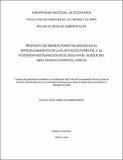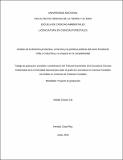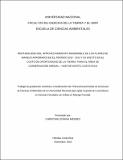| dc.contributor.advisor | Murillo Cruz, Rafael | |
| dc.contributor.author | Mesén Montano, Isaac | |
| dc.date.accessioned | 2023-04-19T22:28:45Z | |
| dc.date.available | 2023-04-19T22:28:45Z | |
| dc.date.issued | 2021 | |
| dc.identifier.uri | http://hdl.handle.net/11056/25207 | |
| dc.description | Trabajo de graduación bajo la modalidad de tesis con formato artículo científico. Licenciatura en Ingeniería en Ciencias Forestales con énfasis en manejo forestal. | es_ES |
| dc.description.abstract | Conocer los factores que afectan el crecimiento de Tectona grandis L. f. clonal, resulta
esencial, para poder determinar la idoneidad de los sitios a ser plantados, asimismo, analizar
espacialmente el crecimiento posestablecimiento, ayuda a identificar áreas que requieren un
tratamiento especial para alcanzar una producción rentable, así como a estimar la producción
alcanzada y sus proporciones. El objetivo de este estudio es determinar los factores edáficos
que influyen en el crecimiento de la especie en suelos rojos fuertemente meteorizados,
además, analizar espacialmente su crecimiento sobre dichos suelos y con ello conocer las
condiciones idóneas para un buen crecimiento, así como la composición productiva espacial
que presentan plantaciones ya establecidas sobre este tipo de suelos. Para ello en
plantaciones clonales de 9,2 años de edad, se estudiaron propiedades físicas y químicas del
suelo en tres profundidades (0-15, 15-30 y 30-60 cm) dentro de 50 parcelas de 500 m2 en
cinco calidades de sitio (18, 21, 24, 27 y 30), además, se realizaron interpolaciones de valores
de altura dominante mediante el programa Arc Map 10.8, empleando los métodos IDW y
Kriging Ordinario e información recabada de 146 parcelas de 500 m2, distribuidas en un área
de 227,1 ha y validadas con base en 27 parcelas adicionales. A partir de lo anterior, se logró
identificar que las variables que condicionan el crecimiento de la especie en suelos rojos son
la Sat Ac alta (> 3 %), la CICE baja (≤ 3,5 cmol(+)*l-1) y el contenido de Fe alto (≥ 80 mg*l-
1) y se logró determinar que las plantaciones alcanzarían un índice de sitio promedio
ponderado de 24,7 m a los 16 años de edad, el área estaría compuesta en un 0,1 %, 12,4 %,
51,0 %, 36,1 % y 0,4 % por los índices de sitio 18, 21, 24, 27 y 30, respectivamente, y que
los valores estimados de altura dominante en las interpolaciones, usando cualquiera de los
dos interpoladores, se desvían en promedio un 10 % de los valores reales, error bastante
aceptable, mostrando ser una buena herramienta de análisis del crecimiento para la especie. | es_ES |
| dc.description.abstract | Know the factors that affect the growth of Tectona grandis L. f. clonal is essential to be able
to determine the suitability of the sites to be planted, likewise, spatially analyze the post-
establishment growth, helps to identify areas that require special treatment to achieve
profitable production, as well as to estimate the production achieved and its proportions. The
objective of this study is to determine the edaphic factors that influence the growth of the
species in strongly weathered red soils, in addition, to spatially analyze its growth on said
soils and thus to know the ideal conditions for its good growth, as well as the spatial
productive composition of plantations already established on this type of soil. For this, in 9.2-
year-old clonal plantations, physical and chemical properties of the soil were studied at three
depths (0-15, 15-30 and 30-60 cm) within 50 plots of 500 m2 in five site qualities (18, 21, 24,
27 and 30), in addition, interpolations of dominant height values were performed through the
Arc Map 10.8 program using the IDW and Ordinary Kriging methods with information
collected from 146 plots of 500 m2 distributed in an area of 227.1 ha and validated based on
27 additional plots. Finding that the variables that condition the growth of the species in red soils are high Ac Sat (> 3 %), low CICE (≤ 3.5 cmol (+) * l-1) and high Fe content (≥ 80
mg*l-1) and determining that the plantations would reach a weighted average site index of
24.7 m at 16 years of age, the area would be composed of 0.1 %, 12.4 %, 51.0 %, 36.1 % and
0.4 % by site indixes 18, 21, 24, 27 and 30 respectively and that the estimated values of
dominant height in the interpolations using either of the two interpolators deviate 10 % from
the real, quite acceptable error, proving to be a good growth analysis tool for the species. | es_ES |
| dc.description.sponsorship | Universidad Nacional, Costa Rica | es_ES |
| dc.language.iso | spa | es_ES |
| dc.publisher | Universidad Nacional, Costa Rica | es_ES |
| dc.rights | Acceso abierto | es_ES |
| dc.rights | Atribución-NoComercial-CompartirIgual 4.0 Internacional | * |
| dc.rights.uri | http://creativecommons.org/licenses/by-nc-sa/4.0/ | * |
| dc.subject | TECA | es_ES |
| dc.subject | TEAK | es_ES |
| dc.subject | MADERA | es_ES |
| dc.subject | WOOD | es_ES |
| dc.subject | SUELOS FORESTALES | es_ES |
| dc.subject | FOREST SOILS | es_ES |
| dc.subject | TECTONA GRANDIS | es_ES |
| dc.subject | PLANTACIÓN FORESTAL | es_ES |
| dc.subject | FOREST PLANTATION | es_ES |
| dc.subject | PRODUCCIÓN FORESTAL | es_ES |
| dc.subject | FOREST PRODUCTION | es_ES |
| dc.title | Factores edáficos que influyen en el crecimiento de plantaciones de teca (Tectona grandis L. f) clonal en suelos fuertemente meteorizados en Pocosol, Alajuela, Costa Rica | es_ES |
| dc.type | http://purl.org/coar/resource_type/c_7a1f | es_ES |
| una.tesis.numero | TESIS 11282 | es_ES |
| dc.description.procedence | Escuela de Ciencias Ambientales | es_ES |




